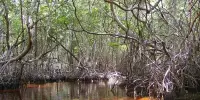According to a comprehensive new climate change study led by the National Center for Atmospheric Research, water resources in snow-dominated regions across the Northern Hemisphere will fluctuate and become increasingly difficult to predict by the end of this century (NCAR).
Even in regions that continue to receive roughly the same amount of precipitation, the research team discovered that streamflow will become more variable and unpredictable. As snowpack melts and fails to provide reliable runoff in a warmer future, the amount and timing of water resources will become increasingly dependent on periodic bouts of rain.
“Water managers will be at the mercy of individual precipitation events rather than having four to six months lead time to anticipate snowmelt and runoff,” said NCAR scientist Will Wieder, the lead author. “Water management systems in snow-dominated regions are based on the predictability of snowpack and runoff, and much of that predictability may be lost as a result of climate change.”
Snowpack is already melting earlier and decreasing in many areas, according to observations. The amount of water contained in snowpack at the end of an average winter in parts of the United States’ Rocky Mountains could drop by nearly 80% by the end of the century, according to scientists.
The study warns that changes in runoff and streamflow are likely to have a domino effect on ecosystems that rely on reliable water from snow. Although the effects will vary by region, more snow-free days and longer growing seasons will strain water resources, drying out soils in many areas and increasing fire risk.
We are in a race with predictability when it comes to streamflow because we’re trying to improve our forecasts through better data, models, and physical understanding, but these efforts are being canceled by the rapid disappearance of our best predictor: snow.
Flavio Lehner
The study assumes that greenhouse gas emissions will continue at a high rate. The most severe impacts on snowpack, runoff, and ecosystems, according to Wieder, would likely be avoided if society successfully reduced greenhouse gas emissions.
The scientists drew on an advanced set of computer simulations to fill in details about the future of water resources, showing the extent to which changes in temperature and precipitation will alter snow accumulation and runoff patterns in the Northern Hemisphere. Although past research looked at the impacts of climate change on water availability, the new study focuses on the increasing variability of water resources.
The study is being published in the Proceedings of the National Academy of Sciences. It was funded by the U.S. National Science Foundation, which is NCAR’s sponsor.
A race with predictability
Many parts of the world rely on snow accumulation during the winter and subsequent melting in the spring and summer to regulate runoff and streamflow. Scientists have been warning for years that the snowpack will become thinner and melt earlier as more precipitation falls as rain instead of snow during the colder months, and as melting occurs at times during the winter rather than the spring runoff season.

Wieder and his co-authors used a powerful NCAR-based climate model, the Community Earth System Model, version 2, to determine how reduced snowpack would affect the variability of water resources. They used a recently created simulation database known as the CESM2 Large Ensemble to compare a past period (1940-1969) with a future period (2070-2099). The simulations were run on the Aleph supercomputer at the Institute for Basic Science supercomputer in Busan, South Korea.
The findings shed light on how widespread changes in the timing and extent of water flows will occur in much of the world by 2100. Assuming high greenhouse gas emissions, the Northern Hemisphere will have about 45 more snow-free days per year. The greatest increases will occur in relatively warm midlatitudes and high-latitude maritime regions influenced by changes in sea ice.
Many regions that rely on predictable relationships between snowpack and runoff will suffer the most predictability loss as a result of a sharp decline in reliable pulses of spring runoff. The Rocky Mountains, the Canadian Arctic, Eastern North America, and Eastern Europe are among these areas. The authors warn that this will substantially complicate the management of freshwater resources, both for society and ecosystems.
“We are in a race with predictability when it comes to streamflow because we’re trying to improve our forecasts through better data, models, and physical understanding, but these efforts are being canceled by the rapid disappearance of our best predictor: snow,” said Flavio Lehner, a professor of earth and atmospheric science at Cornell University and a co-author of the study. “It might be a race we’ll lose, but we’re trying to win it, and that is why we need to study these topics.”
Although reduced runoff will result in drier summertime soil conditions across much of the Northern Hemisphere, simulations show that certain regions, such as East Asia, the Himalayas, and Northwestern North America, will retain soil moisture due to increased rainfall.
“Snow-related metrics are critical for informing society’s management of precious water resources,” said Keith Musselman, co-author of the study and a hydrologist at the University of Colorado Boulder. “As utilities and public works agencies plan new reservoirs and other infrastructure to adapt to climate change, we must address fundamental research questions about the changing characteristics of winter snowpack and resulting streamflow on which we have long relied.”
















